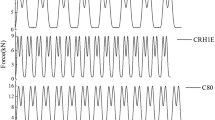Abstract
High-speed train induced vibrations of track structure and underlying soils differ from that induced by low-speed train. Determining the critical speed of train operation remains difficult due to the complex properties of the track, embankment and ground. A dynamic analysis model comprising track, embankment and layered ground was presented based on the two-and-half-dimensional (2.5D) finite elements combining with thin-layer elements to predict vibrations generated by train moving loads. The track structure is modeled as an Euler–Bernoulli beam resting on embankment. The train is treated as a series of moving axle loads; the embankment and ground are modeled by the 2.5D finite elements. The dynamic responses of the track structure and the ground under constant and vibrating moving loads at various speeds are presented. The results show that the critical speed of a train moving on an embankment is higher than the Rayleigh wave velocity of the underlying soil, attributed to the presence of the track structure and the embankment. It is found that the dynamic response of ground induced by moving constant loads is mostly dominated by train speed. While for the moving load with vibration frequency, the ground response is mostly affected by the vibration frequency instead of train speed. Mach effect appears when the train speed exceeds the critical speed of the track–embankment–ground system.
















Similar content being viewed by others
References
Alves Costa P, Calcada R, Silva Cardoso A, Bodare A (2010) Influence of soil non-linearity on the dynamic response of high-speed railway tracks. Soil Dyn Earthq Eng 30:221–235
Bian X, Chen Y (2006) An explicit time domain solution for ground stratum response to harmonic moving load. Acta Mech Sin 22(5):469–478
Bian X, Hu T (2007) Parametric study on embankment-ground vibrations generated by train moving loads. Chin J Rock Mech Eng 26(2):4353–4361
Bian X, Chen Y, Hu T (2008) Numerical simulation of high-speed train induced ground vibrations using 2.5D finite element approach. Sci China Ser G Phys Mech Astron 51(6):632–650
Cai Y, Cao Z, Sun H, Xu C (2009) Dynamic response of pavements on poroelastic half-space soil medium to a moving traffic load. Comput Geotech 36(1):52–60
Cai Y, Cao Z, Sun H, Xu C (2010) Effects of the dynamic wheel–rail interaction on the ground vibration generated by a moving train. Int J Solids Struct 47(17):2246–2259
Dimitrovova Z, Varandas JN (2009) Critical velocity of a load moving on a beam with a sudden change of foundation stiffness: applications to high-speed trains. Comput Struct 87(19–20):1224–1232
Eason G (1965) The stresses produced in a semi-infinite solid by a moving surface force. Int J Eng Sci 2(6):581–609
Esveld C (2001) Modern railway track. MRT Productions, Zaltbommel
Fryba (1972) Vibration of soilds and structure under moving loads. Noordhoff International Publishing, Groningen
Galvin P, Romero A, Dominguez J (2010) Fully three-dimensional analysis of high-speed train-track-soil-structure dynamic interaction. J Sound Vib 329(24):5147–5163
Hsiao-Hui H, Yang YB (2010) Analysis of ground vibrations due to underground trains by 2.5D finite/infinite element approach. Earthq Eng Eng Vib 9(3):327–335
Huang H, Chrismer S (2013) Discrete element modeling of ballast settlement under trains moving at “Critical Speeds”. Constr Build Mater 38:994–1000
Jones CJC, Sheng X, Petyt M (2000) Simulations of ground vibration from a moving harmonic load on a railway track. J Sound Vib 231(3):739–751
Kaynia AM, Madshus C, Zackrisson P (2000) Ground vibration from high-speed trains: prediction and countermeasure. J Geotech Geoenviron Eng 126(6):531–537
Krylov VV (1995) Generation of ground vibrations by superfast trains. Appl Acoust 44(2):149–164
Krylov VV (2001) Noise and vibration from high-speed trains. Institute of Civil Engineers Publish
Madshus C, Kaynia AM (2000) High-speed railway lines on soft ground: dynamic behaviour at critical train speed. J Sound Vib 231(3):689–701
Metrikine AV, Verichev SN, Blaauwendraad J (2005) Stability of a two-mass oscillator moving on a beam supported by a visco-elastic half-space. Int J Solids Struct 42:1187–1207
Sheng X, Jones CJC, Thompson DJ (2004) A theoretical study on the influence of the track on train-induced ground vibration. J Sound Vib 272:909–936
Sheng X, Jones CJC, Thompson DJ (2006) Prediction of ground vibration from trains using the wavenumber finite and boundary element methods. J Sound Vib 293:575–586
Takemiya H (2004) Field vibration mitigation by honeycomb WIB for pile foundations of a high-speed train viaduct. Soil Dyn Earthq Eng 24(1):69–87
Takemiya H, Bian XC (2005) Substructure simulation of inhomogeneous track and layered ground dynamic interaction under train passage. J Eng Mech Asce 131(7):699–711
Vostroukhov A, Metrikine A (2003) Periodically supported beam on a visco-elastic layer as a model for dynamic analysis of a high-speed railway track. Int J Solids Struct 40(21):5723–5752
Yang YB, Hung HH (2001) A 2.5D finite/infinite element approach for modelling visco-elastic bodies subjected to moving loads. Int J Numer Meth Eng 51(11):1317–1336
Yang YB, Hung H (2008) Soil vibrations caused by underground moving trains. J Geotech Geoenviron Eng 134(11):1633–1644
Zhai WM, Wang KY, Cai CB (2009) Fundamentals of vehicle-track coupled dynamics. Veh Syst Dyn 47(11):1349–1376
Zhou H, Jiang J (2006) Ground-borne vibration induced by high-speed trains. Chin J Geotech Eng 28(12):2104–2110
Acknowledgments
Financial support from the Natural Science Foundation of China (Grant Nos. 51178418 and 51222803) is gratefully acknowledged.
Author information
Authors and Affiliations
Corresponding author
Additional information
Invited Paper from the International Symposium on Geotechnical Engineering for High-speed Transportation Infrastructure (IS-GeoTrans 2012), October 26 to 28 2012, Hangzhou, China. Co-Editors Prof. Xiong (Bill) Yu, Case Western Reserve University, USA and Prof. Renpeng Chen, Zhejiang University, China.
Rights and permissions
About this article
Cite this article
Bian, X., Cheng, C., Jiang, J. et al. Numerical analysis of soil vibrations due to trains moving at critical speed. Acta Geotech. 11, 281–294 (2016). https://doi.org/10.1007/s11440-014-0323-2
Received:
Accepted:
Published:
Issue Date:
DOI: https://doi.org/10.1007/s11440-014-0323-2




